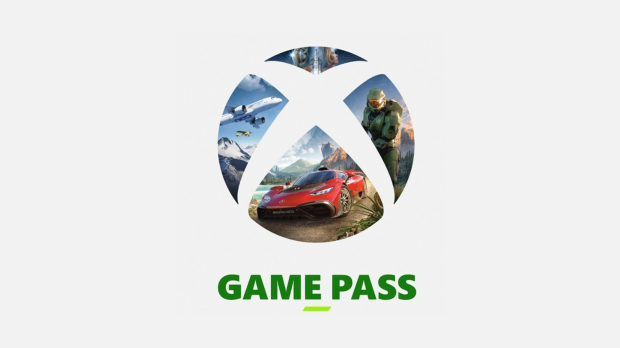Xbox Game Pass is moving to the next phase in its value-oriented subscription model. Here's where Game Pass could go next.
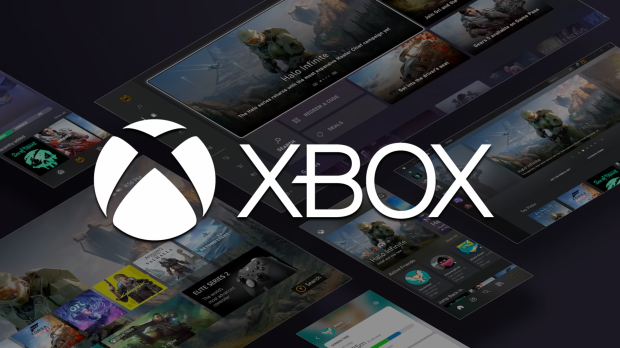
Today reports broke out that Microsoft is raising the price of Game Pass in nearly all countries. Both the base Game Pass and Ultimate subscriptions are increasing to $10.99 and $16.99, respectively. This rise is well-timed in a number of ways. The price increase reflects the global economic situation and is a way to help offset rising costs of goods and services. Games aren't getting any cheaper to make, and 5-6 year development cycles are the new normal.
It's also an opportune time for Microsoft to raise Xbox Game Pass subscription prices ahead of the potential merger with Activision. Microsoft lawyers have told regulators that there are no plans to increase subscription costs if the merger is approved, ergo the pre-emptive hike. The merger has a termination date of July 18, and the price increase goes into effect July 6.
The third reason is the most compelling of all. It's likely that Xbox Game Pass on consoles has met a specific threshold that allows Microsoft to comfortably move to the next phase in the subscription's lifecycle.
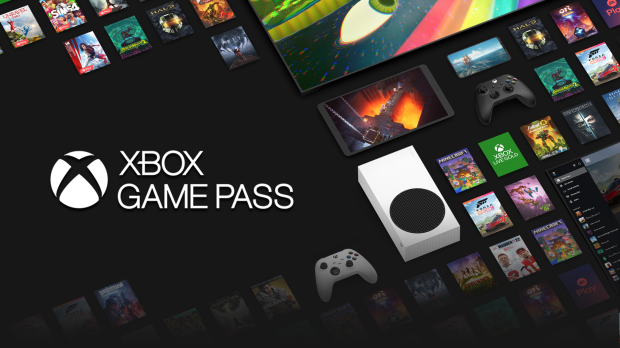
Value-oriented subscriptions have multiple phases. The process is typically similar regardless of the content that's offered. We've seen services like Netflix, HBO Max, and Disney+ follow a similar phase process as PlayStation Plus, Nintendo Switch Online, and now Xbox Game Pass.
I've identified three principal phases that are included in the value-oriented subscription process. Each phase must meet a certain threshold criteria in order to move on to the next phase.
I've identified four major thresholds, which include:
- Number of subscribers
- ARPU (average revenue per user) - The amount that Game Pass subscribers spend on the subscription, on full game sales from within the subscription or while the subscription is active, and in-game through microtransactions
- Engagement - How many people are playing and for how long, what types of games are being played
- Retention - Are users staying subscribed?
Here's what those phases look like in regards to Xbox Game Pass.
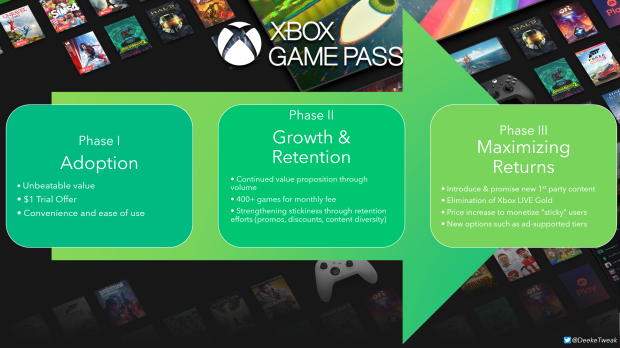
Phase I Adoption
This is the onboarding phase when Microsoft provides such massive value that Game Pass simply can't be ignored. $10 a month (well, now it's $11) for access to over 400+ games? That's a no-brainer, especially now that game are retailing for $69.99 a piece.
Microsoft didn't stop there. The company offers the single greatest value proposition in gaming through its day-one releases. All first-party Xbox games will launch day one on Game Pass, releasing simultaneously on both console and PC as a buy-to-play game and as a downloadable title on Game Pass.
Remember when initial sign-ups were only $1 for 30 days? That was powerful marketing. Everyone was talking about Game Pass back then...until Microsoft nixed the promotion. There's a reason for that; the adoption phase is critical, but it's also the point where the company is at its most vulnerable point. Phase I is where a company can expect to take some losses in exchange for subscribers.
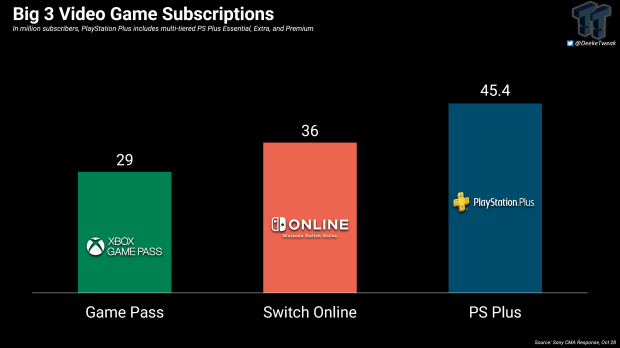
In 3 years' time, Xbox Game Pass has grown from 10 million subscribers to as many as 29 million subscribers.
Phase II - Growth & Retention
Phase I and Phase II have some overlap. Microsoft will see growth over time through its adoption/onboarding efforts, and if the company did its job right (which it did), that growth will compound exponentially.
A few key pillars of Phase II include content diversity and continued value through content volume.
Microsoft talked millions of people into joining Game Pass with its low-cost promotional deal and kept gamers in the ecosystem through a variety of initiatives, including an incredible dearth of content, cross-play and cross-save flexibility features, discounts, and the sheer variety of content that is offered.
A vast games catalog helps keep players engaged and playing titles, but Game Pass goes deeper than that by offering unique and interesting titles from a number of publishers. The more that subscribers play games, the more invested they become in the experiences, and the less likely they are to cancel their subscription--a concept called "churning".
First-party games help fill in the blanks with AAA, AA, and experimental games including deeply-invested online games like Grounded, Sea of Thieves, and Fallout 76 to Obsidian's passion project, Pentiment.
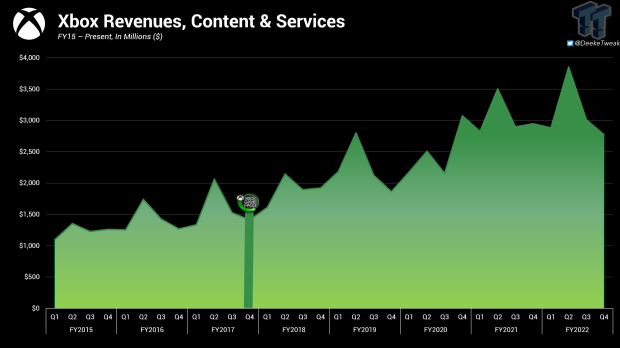
Since the service debuted in 2017, Xbox Game Pass has had a material effect on Microsoft's gaming revenues and has led to multiple years of growth.
Phase III - Maximizing Returns
This is the trickiest step. Some services get this wrong, and receive significant push back (just look at the current discussions around Max).
Phase III is when companies will start raising prices to try and maximize returns on greater content investment. Phase III is most commonly accompanied by an increase in price.
I believe that today's report indicates that Microsoft has moved Xbox Game Pass into Phase III. Only half of Game Pass is currently at this state; Microsoft only raised the price of Xbox Game Pass on console and has kept Game Pass on PC the same price.
The reason? PC Game Pass hasn't hit the require thresholds to move it out of Phase II and into Phase III. Xbox Gaming CEO Phil Spencer strongly reinforces this with his comments on Game Pass on PC made earlier this month:
"Most of our growth right now comes from PC. If you look on Xbox, a lot of the players who already own an Xbox are already in Game Pass. And on PC, you've got kind of a fresh blue ocean there where you can surf away and find new customers--for those that want it, who want to try it."
Read Also: Phil Spencer: 'I think of Xbox Game Pass as a content fund'
Phase III brings with it a new set of rewards and challenges. This is where a service can really evolve and change.
Microsoft has only started the initial changes of Phase III, which includes a price increase. Other changes are more dramatic. We've seen major streamers like Netflix, Disney+, and Max all increase their base subscription prices will making a counter-offer with ad-supported tiers. This way the companies offer more choice while simultaneously testing their subscriber base.
If it works, things go smoothly and the company enjoys a forked subscription model with multiple tiers that monetize users in multiple ways.
There seems to be psychology here, too, and gamers will recognize the methods--they're the same ones used in games with pay-to-win microtransactions.
It goes something like this: Companies create an artificial problem through the introduction of advertisements, and sell subscribers a solution to that problem by having them pay more money to avoid ads. The ultimate expectation and hope is that subscribers shift to become ad-tolerant users because there's typically more money involved with these ad tiers.
So how will Phase III play out for Microsoft? There's a number of things that could happen.

Marquee First-Party Content
All subscription price increases have to be accompanied by new content. Microsoft announced a wave of powerful new first-party games at its recent Xbox Showcase, with Bethesda's new space sim Starfield leading the charge.
There's other games in the pipeline that are cooking in multi-year development cycles like the new Fable reboot, Hellblade II, Machine Games' Indiana Jones project, a new game called Contraband, id Software's next game, a new ZeniMax Online MMORPG, Perfect Dark, and The Elder Scrolls VI that's starting to simmer on the back burner.
Other third-party contracted games include an experimental Xbox game from auteur Hideo Kojima, as well as an interesting fantasy game from Hitman developer IO Interactive that's codenamed Project Dragon.
Promising a wealth of new high-quality first-party content is a big part of Phase III's introduction. But that's not enough; Microsoft has to commit and execute on delivery of these projects if it wants to continue Phase III operations of maximizing returns. This is the challenging part. Microsoft has already laid out a compelling reason for players to shell out more money, but now it has to show subscribers that their money is being put to good use.
This content expansion effort must be simultaneously executed alongside the core value-oriented business model that Game Pass was built on. In other words, Xbox Game Pass has to operate as it does now in terms of content scope, variety, and volume while Microsoft develops and delivers new blockbuster content.
If Microsoft can't achieve this, then it may have to revert back to Phase II...which will be a tough sell considering the price hike is likely permanent.
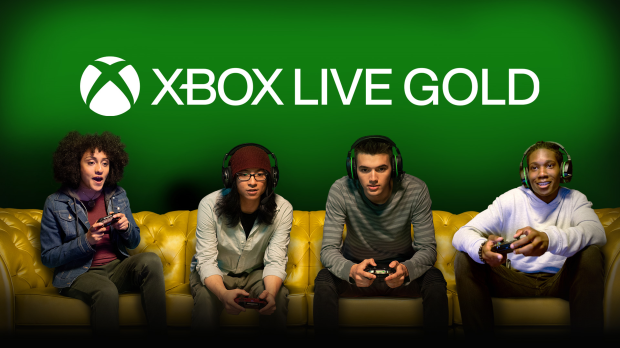
Elimination of Xbox LIVE Gold
Gamers have been calling for this for some time, and it could happen quite soon. Xbox LIVE Gold is seen as redundant because all of its benefits are included in Game Pass.
There's not much difference between the MSRP of Xbox LIVE Gold and Game Pass. However, XBL Gold is an alternative to Game Pass' pricing model. Xbox LIVE Gold subscriptions can convert over to Xbox Game Pass subscription time at a specific conversion rate.
We've included the conversion rates below:
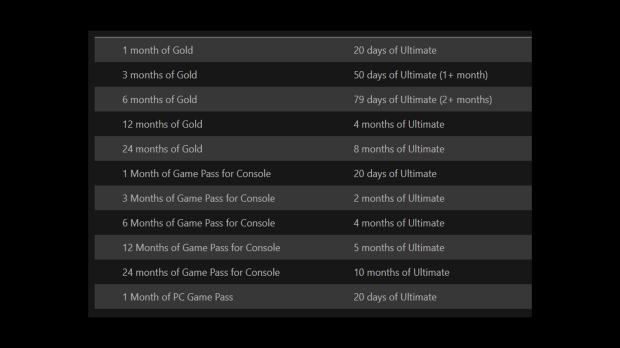
As part of Phase III, Microsoft could eliminate Xbox LIVE Gold to effectively force consumers to buy into Xbox Game Pass. We don't know if and when this will happen, but it would hit two birds with one stone: Users wouldn't have a low-cost alternative, and they also would not be able to take advantage of the conversion rate to stack up cheaper Xbox LIVE Gold vouchers and convert them into Game Pass subscription time.
Microsoft could also introduce a more dramatic shift with the inclusion of advertisements.
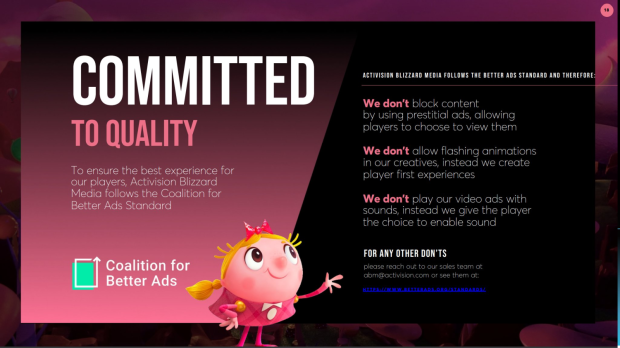
Activision Blizzard Media's advertisement tenets.
Ad-supported Subscription Tiers
It's possible that Microsoft could create a lower-cost ad-supported tier for Xbox Game Pass subscribers, not unlike the ones offered by Netflix, Disney+, Hulu, and Max.
Games industry analyst and expert Joost van Dreunen predicts that both Sony and Microsoft will eventually offer ad-supported tiers of their respective PlayStation Plus and Xbox Game Pass subscriptions.
"Offering an ad-supported subscription is the next logical step for not just Sony and Microsoft but the broader digital entertainment market, whether we like it or not," van Dreunen said in his newsletter (sign up here).
"Over the course of the next few years, we can expect to see ads appearing where they previously weren't. The time in which video games were so-called 'pure play' spaces, meaning void of any commercial messaging, is over."
Microsoft does own an ad-tech platform--a system used to deploy advertisements in services and apps--following its purchase of Xandr in 2021. Microsoft also wants to purchase Activision Blizzard King for $68.7 billion, and King has an incredibly potent ad tech platform that leverages the Activision Blizzard Media label to secure billion-dollar ad contracts.
Xbox executives have also talked about advertisements in gaming. Here's what Xbox exec Sarah Bond said in a recent interview with Rolling Stone:
"We've talked about how we're experimenting with other models, like what does it mean for advertising in games which is more prevalent in mobile - are there models of that that work well in PC and console?
"Are there other models where you might have timed slices of games and stuff like that? Providing creators with options and choice enables them to experiment and do what they like, and actually create more immersive and creative experiences without having to fit into a mold."
There's no indication if and when ads will be included into Game Pass, so this one is more theoretical and hypothetical.
Here's more required reading on the topic of ads showing up in game subscriptions:

